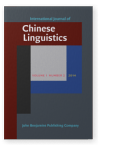Left periphery and Chinese yes-no questions
Assuming the cartographic approach (Rizzi 1997, 2004; Cinque 1999), this study attempts to map four Chinese yes-no question markers onto the left periphery, including ke/shifou/A-not-A in Mandarin Chinese and kam in Taiwan Southern Min. It is found that while these four markers all represent yes-no questions, they are not exactly alike on syntactic grounds. The syntactic behavior of ke is particularly different in that it is not able to lead an embedded null-subject question whereas kam/shifou/A-not-A are able to. Also, ke in its own right cannot license the focus interpretation of its following NP or clause whereas kam/shifou/A-not-A (MEpi-not-MEpi) can. Given these differences, this study proposes a topography and attributes them to different projections of the question markers in the fine structure of split CPs, where ke is merged in Fin0 and raised to Int0 in LF, while kam/shifou/A-not-A(MEpi-not-MEpi) are merged in SpecFocP and raised to SpecIntP in LF. VP-not-VP forms, however, are not base-generated in CP, but within TP/IP. They are subsequently forced to raise to SpecIntP in LF to check the feature [+Q].
References
Adger, M., & Quer, J
(
2001)
The syntax and semantics of unselected embedded questions.
Language, 77(1), 107–133.


Cheng, L.L.-S., Huang, C.-T.J, & Tang, C.-C.J
Chomsky, N
(
1981)
Lectures on government and binding. Dordrecht: Foris.

Chomsky, N
(
1986)
Knowledge of language: Its nature, origin, and use. New York: Praeger.

Cinque, G
(
1999)
Adverbs and functional heads. Oxford & New York: Oxford University Press.

Ernst, T
(
1994)
Conditions on Chinese A-not-A questions.
Journal of East Asian Linguistics, 31, 241–264.


Fu, J
(
1994)
SOV word order in Chinese and IP specifier. Paper presented at the 6th North American Conference on Chinese Linguistics. Los Angeles: University of Southern California.
Haegeman, L
(
1994)
Introduction to government and binding. 2nd ed. Oxford: Blackwell.

He, Y
(
2011)
Xiandai Hanyu shengcheng yufa [
A generative grammar of Mandarin Chinese]. Beijing: Peking University Press.

Huang, C.-T.J
(
1982)
Logical relations in Chinese and the theory of grammar (Unpublished doctoral dissertation). MIT, Cambridge.
Huang, C.-T.J
(
1991)
Modularity and Chinese A-not-A questions. In
C. Georgopoulos &
R. Ishihara (Eds.),
Interdisciplinary approaches to language: Essays in honor of S.-Y. Kuroda (pp. 305–332). Dordrecht: Kluwer.


Kayne, R.S
(
1991)
Romance clitics, verb movement, and PRO.
Linguistic Inquiry, 22(4), 647–686.

Lau, S
(
2010)
Syntax of kam questions in Taiwanese (Unpublished master thesis). National Taiwan Normal University, Taipei.

Law, P
(
2006)
Adverbs in A-not-A questions in Mandarin Chinese.
Journal of East Asian Linguistics, 151, 97–136.


Lee, H
(
2005)
On Chinese focus and cleft constructions (Unpublished doctoral dissertation). National Tsing Hua University, Hsinchu.
Lin, T.J
(
2011)
Finiteness of clauses and raising of arguments in Mandarin Chinese.
Syntax, 14(1), 48–73.


Montague, R
(
1970)
Universal grammar.
Theoria, 361, 373–398.


Paul, W
(
2002)
Sentence-internal topics in Mandarin Chinese: The case of object preposing.
Language and Linguistics, 3(4), 695–714.

Rizzi, L
(
1997)
The fine structure of the left periphery. In
L. Haegeman (Ed.),
Elements of grammar: Handbook in generative syntax (pp. 281–337). Dordrecht: Kluwer.


Rizzi, L
(
2004)
Locality and left periphery. In
A. Belletti (Ed.),
Structures and beyond (pp. 223–251). Oxford & New York: Oxford University Press.

Simpson, A., & Wu, Z
(
2002)
IP-raising, tone sandhi and the creation of S-final particles: Evidence for cyclic Spell-Out.
Journal of East Asian Linguistics, 11(1), 67–99.


Tang, C.-C.J
(
2001)
Functional projections and adverbial expressions in Chinese.
Language and Linguistics, 2(2), 203–241.

Tang, T.-C
(
1988)
Hanyu cifa jufa lunji [
Studies on Chinese morphology and syntax]. Taipei: Student Book Co.

Tang, T.-C
(
1999)
Hanyu de zhengfan wenju: Beijingyu yu Minnanyu de bijiao fenxi [A-not-A questions in Mandarin Chinese: A comparative analysis between Beijing Mandarin and Southern Min]. In
Y. Yin,
I. Yang, &
H. Chan (Eds.),
Chinese languages and linguistics, V, Interactions in language (pp. 27–71).Taipei: The Institute of History and Philosophy, Academia Sinica.

Tang, T.-C
(
2000)
Hanyu de xianding ziju yu feixianding ziju [Finite and nonfinite clauses in Chinese].
Language and Linguistics, 1(1), 191–214.

Tsai, W.D
(
1994)
On economizing the theory of A-bar dependencies (Unpublished doctoral dissertation). MIT, Cambridge.
Tsai, W.D
(
1999)
On lexical courtesy.
Journal of East Asian Linguistics, 8(1), 39–73.


Tsai, W.D
(
2008)
Left periphery and how-why alternations.
Journal of East Asian Linguistics, 17(2), 83–115.


Tsai, W.D
(
2010)
Tan Hanyu motaici de fenbu yu quanshi zhi duiying guanxi [On the syntax-semantics correspondences of Chinese modals].
Zhongguo Yuwen [
Studies of the Chinese Language], 2010(3), 208–221.

Wang, P., & Lien, C
(
2001)
A-not-A questions in Taiwanese Southern Min.
Journal of Chinese Linguistics, 29(2), 351–376.

Wei, P
(
2007)
Cong foudingci dao yiwen zhuci [From negators to question particles].
Bulletin of Chinese Linguistics, 1(2), 23–57.


Wei, P
(
2010)
Shifou-V(N)P jushi de youlai [The history of the interrogative structure
shifou-V(N)P].
Language and Linguistics, 11(2), 335–392.

Zhang, M
(
1990)
A typological study of yes-no questions in Chinese dialects: A diachronic perspective (Unpublished doctoral dissertation). Peking University, Beijing.
Zhang, N.N
(
1997)
Syntactic dependencies in Mandarin Chinese (Unpublished doctoral dissertation). University of Toronto, Toronto.
Zhang, Z
(
1997)
Focus, presupposition and the formation of A-not-A questions in Chinese.
Journal of Chinese Linguistics, 25(2), 227–257.

Zhu, D
(
1991)
V-neg-VO yu VO-neg-V liang-zhong fanfu wenju zai Hanyu fangyan-li de fenbu [The distribution of V-neg-VO and VO-neg-V questions in Chinese dialects].
Zhongguo Yuwen [
Studies of the Chinese Language], 19911, 321–332.

Cited by
Cited by 2 other publications
Jin, Dawei
2022.
The intervention effect in suzhounese polar questions.
Poznan Studies in Contemporary Linguistics 58:4
► pp. 775 ff.

Shyu, Shu-ing & Lio̍k-san N̂g
This list is based on CrossRef data as of 3 july 2024. Please note that it may not be complete. Sources presented here have been supplied by the respective publishers.
Any errors therein should be reported to them.
